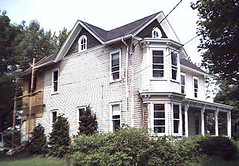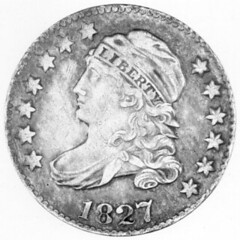
PREV ARTICLE
NEXT ARTICLE
FULL ISSUE
PREV FULL ISSUE
"HONEY, I HID THE COIN COLLECTION!"
We knew something was there, but didn't know what or where it was hidden. When the last of us arrived, we would start. I anticipated going through drawers and dusty closets, sorting through papers and junk. Would I find a rare autograph? A valuable First Edition? Coins? Or would the treasure be an old lamp or piece of jewelry? I fantasized that I would be the hero and recognize whatever it was after the whole crew had passed it by without notice. But I also feared that I'd be the clueless one, not recognizing the true treasure if it were handed to me on a velvet pillow by glowing angels. I woke up before the search ever began, so I guess I'll never know how the story ended. But that day when I came home from work some mail was waiting for me on my desk. Near the bottom of the stack was my copy of the May 2012 issue of the John Reich Journal, a publication of the John Reich Collectors Society. I was drawn to an article by John McCloskey titled "The David J. Davis Bust Dime Collection". Dave was a longtime E-Sylum subscriber who'd passed away recently. I had met him several times at various coin shows and NBS events. He was always doing some numismatic research, or assisting others with theirs. It's a great article that describes how Davis, McCloskey and others came to write the definitive reference on U.S. Bust Dimes. Here are two excerpts from the article, which JR Journal Editor Brad Karoleff kindly forwarded at my request. The second part stopped me in my tracks when I saw it. Read on to learn the connection to my dream.
Here's the part about the book... Pictured is an 1827 dime from the cover of the December 2011 JR Journal.
-Editor
I began collecting Bust dimes in 1969 and initially planned to obtain a date set from 1809 to 1837. However, when I upgraded the pieces in my collection I quickly noticed differences in date styles for coins with the same date, differences in the placement of the lettering and stars around the periphery of the obverse and reverse designs as well as die scratches, die cracks and cuds that appeared on only a fraction of the coins of a given date. I began to prepare written descriptions for the pieces I owned to see if they matched the features of new pieces I encountered at shows. When I found a piece that didn't match the description for any of the pieces that I owned, I bought it. I realized I needed help identifying the die marriages for Bust dimes and sought out other collectors with experience in this field. I remember reading an article in Coin World by Walter Breen in the early 1970s describing the different date styles on 1835 Bust dimes. I wrote a letter to Breen asking him if he could provide me with the names of other collectors with whom I could work in identifying die marriages of Bust dimes. It wasn't long before I received his reply with an address for David Davis indicating that this individual was a serious numismatic scholar with extensive knowledge of Bust coinage. I quickly contacted David Davis and it wasn't long before we were meeting at local coin shows and exchanging information on the coins that we had purchased in the Bust dime series. Within a few months we met Russ Logan at a local show in Ohio and the three of us started comparing notes on the coins in our die marriage collections. This work led to the foundation that resulted in the die marriage descriptions for the dime book that was published in 1984. Over a period of twelve years the three of us identified 122 die marriages for the Capped Bust dime series from 1809 to 1837. David Davis completed this die variety set and retained his collection until his death on November 2, 2011.
Now cue the eerie music...
-Editor
In his will, David asked me to facilitate the sale of [his] important collection for his estate. In December 2011 David's widow Janet Davis withdrew the collection from the bank vault in Michigan and gave it to me to document for sale at auction. Upon receipt of the coins I prepared a listing that included 136 pieces from the collection. I discovered that there were many duplicates in the set but surprisingly, many of the rare dates were missing. There were no 1809, 1811, 1814, 1822, 1823, 1824 or 1825 dimes and some of the die marriages were missing for the 1820, 1821, 1827 and 1829 dates. This was a disaster because we didn't have a complete collection and many of the important pieces were missing. I contacted Janet with this news and she was unable to explain what happened to the lost pieces. After discussing this issue with a number of people who knew David, we finally obtained an explanation for the missing coins. David had been seriously ill for over two years before his death and at various times he underwent some very demanding sessions in the treatment for his illness. However, he was well enough to attend the ANA Convention in Boston during August 2010. It seems that he had taken some of the coins in his collection from the vault before the ANA Convention and forgot to return them before leaving for Boston. Not wanting them to be stolen in his absence, he hid them in what he considered to be a very safe place around the house. After undergoing subsequent treatments for his illness, he confided to one of his coin friends that he couldn't remember where he had hidden the missing dimes. After his death nobody knew where to look for the lost pieces. Janet Davis now had a very serious problem; she simply didn't know where to look for the missing dimes. After a number of searches produced no coins, she decided to invite several family members over for a complete search of the Davis home in a final effort to resolve the problem. This time the coins were found in a well hidden place that no burglar would have been able to find. Fortunately however, the family was eventually able to locate the lost pieces to present the entire collection for sale. The secret hiding place produced 63 more Bust dimes including examples of the rare dates that had been missing.
OK, was that weird, or what? Thank Goodness for the Davis Family and the numismatic hobby that the pieces were found. I'll admit to having misplaced some items of my own collection in the past, including a (thankfully common) U.S. encased postage stamp. Who else will 'fess up? What have readers misplaced?
-Editor
For more information about the John Reich Collectors Society, see:
www.jrcs.org
The Numismatic Bibliomania Society is a non-profit organization promoting numismatic literature. See our web site at coinbooks.org. To submit items for publication in The E-Sylum, write to the Editor at this address: whomren@gmail.com To subscribe go to: https://my.binhost.com/lists/listinfo/esylum All Rights Reserved. NBS Home Page Contact the NBS webmaster 
|

